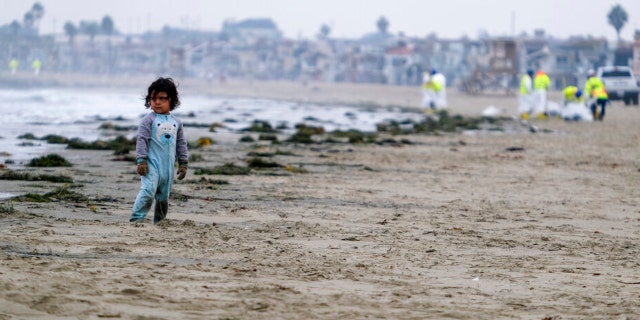Investigators searching for the cause of an energy” target=”_blank”>oil pipeline< coast have pointed to the possibility that a ship anchor dragged the line across the environment and cracked it, but two videos released so far provide only tantalizing clues about what might have happened 100 feet (30 meters) below the ocean surface.
A military video released Thursday appears to show a trench in the seafloor leading to a bend in the submerged line, but experts offered varied opinions of the significance of the brief, grainy shots. An earlier video revealed a 13-inch (33-centimeter) rupture in the line, but the pipe showed no evidence of damage that they said would be expected from a collision with a multi-ton anchor from cargo ships that routinely move through the area off the ports of los-angeles” target=”_blank”>Los Angeles<
The slight bow in the line displayed in one video “doesn’t necessarily look like anchor damage,” Frank G. Adams, president of Houston-based Interface Consulting International, said in an email. When a pipeline is hit by an anchor or other heavy object “that typically results in physical damage that may lead to a fracture.”
Ramanan Krishnamoorti, a petroleum engineering professor at the houston-and-galveston” target=”_blank”>University of Houston< to at least about 25,000 gallons (95,000 liters) and no more than 132,000 gallons (500,000 liters).
The agency said it is investigating the incident with other agencies as a “major marine casualty” due to the potential involvement of a vessel and damages exceeding $500,000. It said they will determine if criminal charges, civil penalties or new laws or regulations are needed.
CALIFORNIA OIL SPILL STATE OF EMERGENCY: CRIMINAL, CIVIL PROBES REPORTEDLY LAUNCHED
The leak occurred about 5 miles (8 kilometers) offshore at a depth of about 98 feet (30 meters), investigators said. A 4,000-foot (1,219-meter) section of the pipeline was dislodged 105 feet (32 meters), bent back like the string on a bow, Amplify’s CEO Martyn Willsher has said.
Jonathan Stewart, a professor of civil and environmental engineering at the University of California, Los Angeles, said he was surprised the damage wasn’t more severe given how far the pipe was moved.
“My first reaction when I heard that it is displaced so far was that it’s remarkable that it’s even intact at all,” Stewart said.

A boy stands on the sands as workers in protective suits clean the contaminated beach after an oil spill in Newport Beach, Calif., on Thursday, Oct. 7, 2021. A major oil spill off the coast of Southern California fouled popular beaches and killed wildlife while crews scrambled Sunday, to contain the crude before it spread further into protected wetlands.
(AP Photo/Ringo H.W. Chiu)
Moving a large section of pipe up to 105 feet (32 meters) would have caused “bending deformations” – tension on the side that was stretched into a semicircle, with compression on the other, as it was bent inward, Stewart said.
It’s possible such pressure alone could result in a break, though Stewart said there is too little information to make a conclusion about the cause. It’s possible a sharp section of anchor could pierce the pipeline but “you could still have damage just from the bending.”
“Because it’s pulling on the pipe, you create these bending stresses in the pipe, which could eventually become large enough that they rupture it,” he said.
Questions remain about when the oil company knew it had a problem and delays in reporting the spill.
A foreign ship anchored in the waters off Huntington Beach reported to the Coast Guard that it saw a sheen longer than 2 miles (3 kilometers) just after 6 p.m. A satellite image shot by the air-and-space” target=”_blank”>European Space Agency< is big enough to allow some oil to escape to potentially trigger the low pressure alarm, Kuprewicz said. But because the pipeline was operating under relatively low pressure, the control room operator may have simply dismissed the alarm because the pressure was not very high to begin, he said.
CLICK HERE TO GET THE FOX NEWS APP
Because the line is encased in concrete — a means of keeping it weighted down on the sea floor — the Coast Guard videos don’t reveal the condition of the half-inch-thick steel pipe underneath.
Once federal safety investigators cut out the damaged section of pipe and remove it, they will be able to conduct a closer examination, looking for signs of corrosion, metal fatigue or other anomalies that would have made it more susceptible to failure. That examination should also reveal if the crack grew larger over time, Kuprewicz said.









